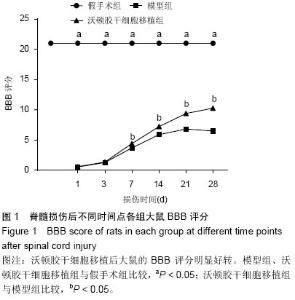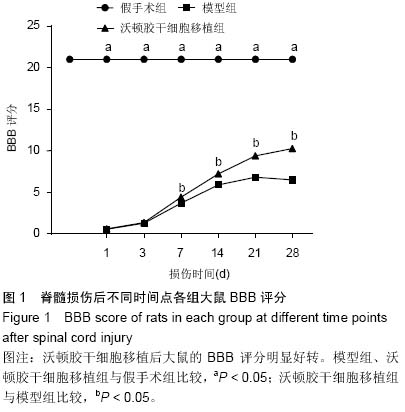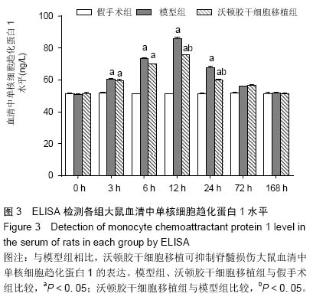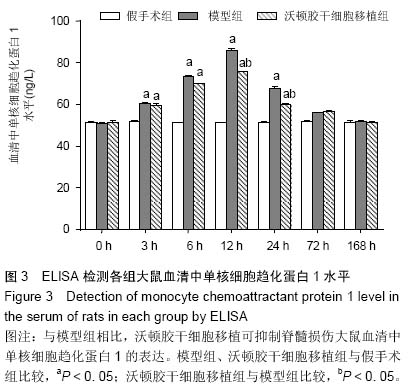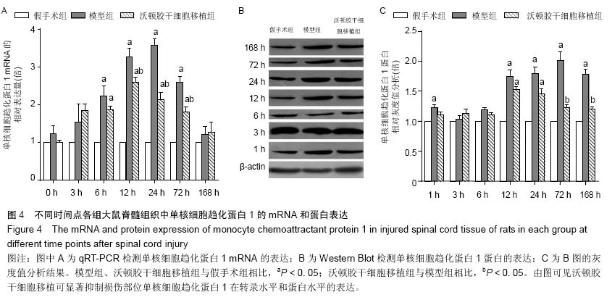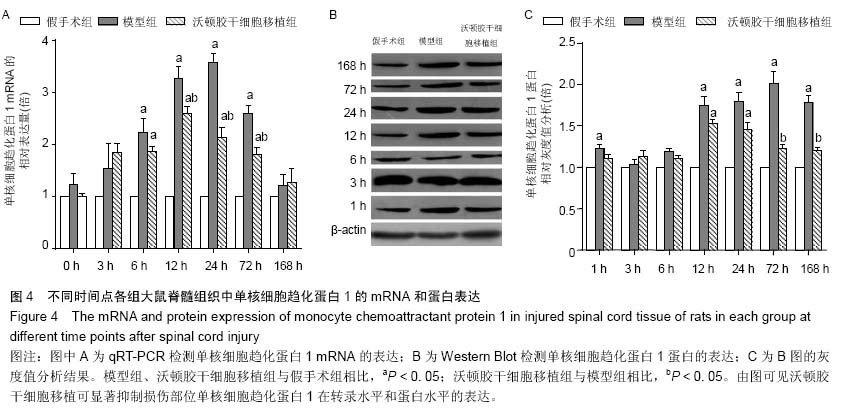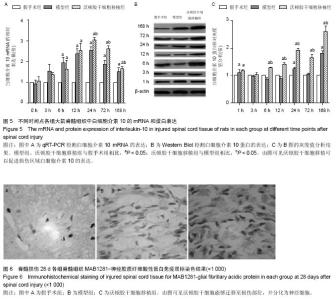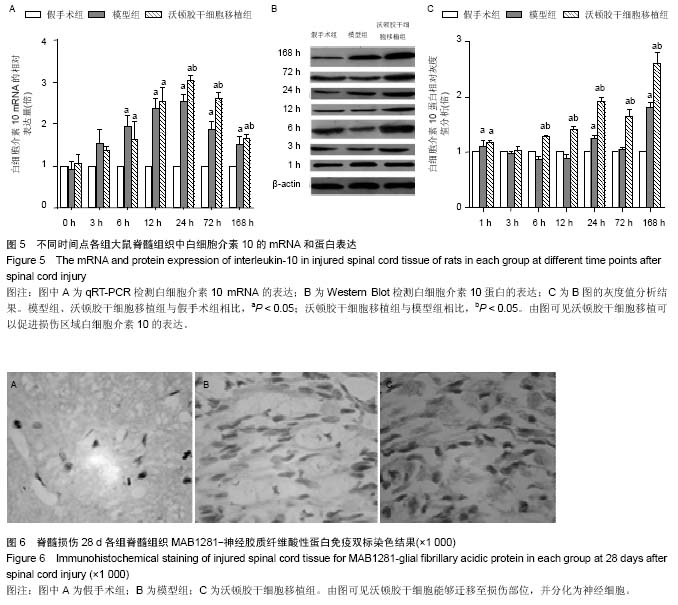Chinese Journal of Tissue Engineering Research ›› 2015, Vol. 19 ›› Issue (23): 3729-3735.doi: 10.3969/j.issn.2095-4344.2015.23.021
Previous Articles Next Articles
Effects of umbilical cord Wharton’s jelly mesenchymal stem cell transplantation on the expression of inflammatory factors in rats with spinal cord injury
Ma Shan-shan1, Qu Rui-na1, Tian Yi2, Yao Ning1, Cui Yuan-bo1, Han Kang1, Xing Qu1, Yang Bo2, Guan Fang-xia1, 2
- 1School of Life Sciences, Zhengzhou University, Zhengzhou 450001, Henan Province, China;
2Department of Neurosurgery, First Affiliated Hospital of Zhengzhou University, Zhengzhou 450052, Henan Province, China
-
Online:2015-06-04Published:2015-06-04 -
Contact:Guan Fang-xia, Professor, Doctoral supervisor, School of Life Sciences, Zhengzhou University, Zhengzhou 450001, Henan Province, China; Department of Neurosurgery, First Affiliated Hospital of Zhengzhou University, Zhengzhou 450052, Henan Province, China -
About author:Ma Shan-shan, M.D., Associate professor, School of Life Sciences, Zhengzhou University, Zhengzhou 450001, Henan Province, China -
Supported by:the National Natural Science Foundation of China, No. 81171177; U1404313; a grant from Science & Technology Innovation Foundation for Higher Education Institutes of Henan Province of China, No. 15IRTSTHN022
CLC Number:
Cite this article
Ma Shan-shan, Qu Rui-na, Tian Yi, Yao Ning, Cui Yuan-bo, Han Kang, Xing Qu, Yang Bo, Guan Fang-xia. Effects of umbilical cord Wharton’s jelly mesenchymal stem cell transplantation on the expression of inflammatory factors in rats with spinal cord injury [J]. Chinese Journal of Tissue Engineering Research, 2015, 19(23): 3729-3735.
share this article
| [1] Torres-Espín A, Redondo-Castro E, Hernández J, et al. Bone marrow mesenchymal stromal cells and olfactory ensheathing cells transplantation after spinal cord injury--a morphological and functional comparison in rats. Eur J Neurosci. 2014; 39(10):1704-1717. [2] Oliveri RS, Bello S, Biering-Sørensen F. Mesenchymal stem cells improve locomotor recovery in traumatic spinal cord injury: systematic review with meta-analyses of rat models. Neurobiol Dis. 2014;62:338-353. [3] Wang L, Wang Q, Zhang XM. Progress on bone marrow mesenchymal stem cells transplantation for spinal cord injury. Zhongguo Gu Shang. 2014;27(5):437-440. [4] Yao LQ, He C, Zhao Y,et al.Human umbilical cord blood stem cell transplantation for the treatment of chronic spinal cord injury.Neural Regen Res. 2013;8(5): 397-403 [5] Zhang C, He XJ, Li HP,et al.Chondroitinase ABC plus bone marrow mesenchymal stem cells for repair of spinal cord injury.Neural Regen Res. 2013;8(11): 965-974 [6] Tanna T, Sachan V. Mesenchymal stem cells: potential in treatment of neurodegenerative diseases. Curr Stem Cell Res Ther. 2014;9(6):513-521. [7] Dasari VR, Veeravalli KK, Dinh DH. Mesenchymal stem cells in the treatment of spinal cord injuries: A review. World J Stem Cells. 2014;6(2):120-133. [8] 魏开斌,卓锋,刘红,等. 移植脐带间充质干细胞治疗脊髓损伤的实验研究[J].中国矫形外科杂志,2012,20(22):2081-2085. [9] 刘静,韩冬梅,王志东,等.脐带间充质干细胞治疗脊髓损伤临床分析[J].中华损伤与修复杂志:电子版,2011,6(4):564-570, 576. [10] 王颖,冯世庆,赵鹏,等.大鼠脊髓损伤后不同时期移植人脐带间充质干细胞的修复效果观察[J].中国脊柱脊髓杂志,2010,20(11): 918-925. [11] 韩明远,冯世庆,李辉,等. 移植人脐带间充质干细胞修复大鼠脊髓损伤[J].中国组织工程研究与临床康复,2010,14(19):3483- 3489. [12] 朱玉海,冯世庆,孔晓红,等. 人脐带间充质干细胞与自体激活雪旺细胞联合移植修复脊髓损伤的实验研究[J].中华创伤骨科杂志,2009,11(8):747-751. [13] Ormond DR, Shannon C, Oppenheim J, et al. Stem cell therapy and curcumin synergistically enhance recovery from spinal cord injury. PLoS One. 2014;9(2):e88916. [14] 锁志刚,丁惠强,飞翔,等. Caspase-1及其下游炎症因子在大鼠脊髓损伤中的表达及意义[J].宁夏医科大学学报, 2011, 33(1):48-51. [15] Nelissen S, Vangansewinkel T, Geurts N, et al. Mast cells protect from post-traumatic spinal cord damage in mice by degrading inflammation-associated cytokines via mouse mast cell protease 4. Neurobiol Dis. 2014;62:260-272. [16] 徐玉生,李星辰,金伟林,等.褪黑素对大鼠急性脊髓损伤后不同时期IL-10表达的影响[J].郑州大学学报:医学版, 2013, 48(2): 193-197. [17] 渠瑞娜,马珊珊,田毅,等.人脐带沃顿胶干细胞对急性大鼠脊髓损伤的作用及脊髓组织中 TNF-α和 BDNF 表达的影响[J]. 郑州大学学报:医学版, 2014, 49(6):765-769. [18] 张文进,黄华,关方霞,等.人脐带间充质干细胞治疗脊髓损伤及其对内源性细胞增殖的影响[J]. 实用医学杂志, 2013, 29(6): 880-882. [19] 董锋,林建华,吴朝阳.骨髓间质干细胞经静脉移植对大鼠脊髓损伤后TNF-α、IL-1β mRNA表达的影响[J]. 中国骨与关节损伤杂志, 2010, 25(8):697-699. [20] Tsumuraya T, Ohtaki H, Song D, et al. Human mesenchymal stem/stromal cells suppress spinal inflammation in mice with contribution of pituitary adenylate cyclase-activating polypeptide (PACAP). J Neuroinflammation. 2015;12:35. [21] Urdzíková LM, R??i?ka J, LaBagnara M, et al. Human mesenchymal stem cells modulate inflammatory cytokines after spinal cord injury in rat. Int J Mol Sci. 2014;15(7): 11275- 11293. [22] Basso DM, Beattie MS, Bresnahan JC. A sensitive and reliable locomotor rating scale for open field testing in rats. J Neurotrauma. 1995;12(1):1-21. [23] Livak KJ, Schmittgen TD. Analysis of relative gene expression data using real-time quantitative PCR and the 2(-Delta Delta C(T)) Method. Methods. 2001;25(4):402-408. [24] Cheng T, Yang B, Li D, et al. Wharton's Jelly Transplantation Improves Neurologic Function in a Rat Model of Traumatic Brain Injury. Cell Mol Neurobiol. 2015 Feb 1. [Epub ahead of print] [25] 王革生, 张庆俊, 韩忠朝. 人脐带间充质干细胞移植对大鼠脊髓损伤神经功能恢复的评价[J].中华神经外科杂志,2006, 22(1): 18-21. [26] 朱青,汪晶,刘元渊,等.脊髓损伤的病理机制和细胞移植治疗进展[J].神经损伤与功能重建, 2013, 8(3): 217-220. [27] 谢周通,徐皓,陈建梅,等.免疫因素在脊髓损伤中的作用[J].中国组织工程研究, 2013, 17(37): 6664-6670. [28] 郑晶晶,姚安会,刘芳芳,等.小鼠脊髓损伤早期不同炎症因子的表达变化[J]. 细胞与分子免疫学杂志, 2012, 28(4):391-394. [29] 王晓凯,孙天胜,李放,等. SIRT1对大鼠急性脊髓损伤炎症反应的影响[J]. 中华临床医师杂志, 2012, 6(12):3250-3253. [30] 张群,王竞秋,宋焱峰,等.大鼠急性脊髓损伤后MCP-1及BDNF表达变化的实验研究[J].甘肃医药, 2013, 32(3): 184-186. [31] Yang CC, Shih YH, Ko MH, et al. Transplantation of human umbilical mesenchymal stem cells from Wharton's jelly after complete transection of the rat spinal cord. PLoS One. 2008; 3(10):e3336. [32] Zhang L, Zhang HT, Hong SQ, et al. Cografted Wharton's jelly cells-derived neurospheres and BDNF promote functional recovery after rat spinal cord transection. Neurochem Res. 2009;34(11):2030-2039. [33] 赵峰,李圣青,遆新宇,等.骨髓间充质干细胞对肺损伤大鼠转化生长因子β及单核细胞趋化蛋白1的影响[J].中国组织工程研究与临床康复, 2008,12(29): 5627-5630. [34] 罗文芳. 脑出血大鼠神经干细胞移植后IL-2、IL-10的表达及中药干预的影响[D]. 长沙:中南大学, 2008. [35] Wakabayashi K, Nagai A, Sheikh AM, et al. Transplantation of human mesenchymal stem cells promotes functional improvement and increased expression of neurotrophic factors in a rat focal cerebral ischemia model. J Neurosci Res. 2010;88(5):1017-1025. [36] Wei CC, Lin AB, Hung SC. Mesenchymal stem cells in regenerative medicine for musculoskeletal diseases: bench, bedside, and industry. Cell Transplant. 2014;23(4-5):505-512. [37] Tan Y, Uchida K, Nakajima H, et al. Blockade of interleukin 6 signaling improves the survival rate of transplanted bone marrow stromal cells and increases locomotor function in mice with spinal cord injury. J Neuropathol Exp Neurol. 2013; 72(10):980-993. [38] 孔令胜,靳峰,郭强,等.胎鼠神经干细胞移植对大鼠脊髓损伤后神经元特异性烯醇化酶和皮质体感诱发电位的影响研究[J].中国全科医学,2013,16(6):639-643. [39] Dai G, Liu X, Zhang Z, et al. Transplantation of autologous bone marrow mesenchymal stem cells in the treatment of complete and chronic cervical spinal cord injury. Brain Res. 2013;1533:73-79. [40] 董锋,林建华,吴朝阳. 骨髓间充质干细胞静脉移植脊髓损伤大鼠肿瘤坏死因子α及白细胞介素1β的表达[J].中国组织工程研究, 2012, 16(36):6730-6735. [41] 张健,李勇,王文军,等. HUCMSCs移植对大鼠亚急性脊髓损伤GAP-43和SPRR1A蛋白表达及神经功能的影响[J].医学临床研究,2013,30(6):1070-1073. [42] 白金柱,王岩,刘忠军,等.经静脉移植间充质干细胞在脊髓损伤鼠体内的迁移[J].中国临床康复,2006,10(25):30-33. [43] 周志刚,李志忠,林永新,等.人脐带间充质干细胞定向诱导分化成类神经元的实验研究[J].中国病理生理杂志,2015,31(2):229- 233. |
| [1] | Jiang Tao, Ma Lei, Li Zhiqiang, Shou Xi, Duan Mingjun, Wu Shuo, Ma Chuang, Wei Qin. Platelet-derived growth factor BB induces bone marrow mesenchymal stem cells to differentiate into vascular endothelial cells [J]. Chinese Journal of Tissue Engineering Research, 2021, 25(25): 3937-3942. |
| [2] | Chen Yang, Huang Denggao, Gao Yuanhui, Wang Shunlan, Cao Hui, Zheng Linlin, He Haowei, Luo Siqin, Xiao Jingchuan, Zhang Yingai, Zhang Shufang. Low-intensity pulsed ultrasound promotes the proliferation and adhesion of human adipose-derived mesenchymal stem cells [J]. Chinese Journal of Tissue Engineering Research, 2021, 25(25): 3949-3955. |
| [3] | Zhang Lishu, Liu Anqi, He Xiaoning, Jin Yan, Li Bei, Jin Fang. Alpl gene affects the therapeutic effect of bone marrow mesenchymal stem cells on ulcerative colitis [J]. Chinese Journal of Tissue Engineering Research, 2021, 25(25): 3970-3975. |
| [4] | Ruan Guangping, Yao Xiang, Liu-Gao Miyang, Cai Xuemin, Li Zian, Pang Rongqing, Wang Jinxiang, Pan Xinghua. Umbilical cord mesenchymal stem cell transplantation for traumatic systemic inflammatory response syndrome in tree shrews [J]. Chinese Journal of Tissue Engineering Research, 2021, 25(25): 3994-4000. |
| [5] | Mo Jianling, He Shaoru, Feng Bowen, Jian Minqiao, Zhang Xiaohui, Liu Caisheng, Liang Yijing, Liu Yumei, Chen Liang, Zhou Haiyu, Liu Yanhui. Forming prevascularized cell sheets and the expression of angiogenesis-related factors [J]. Chinese Journal of Tissue Engineering Research, 2021, 25(22): 3479-3486. |
| [6] | Chen Lei, Zheng Rui, Jie Yongsheng, Qi Hui, Sun Lei, Shu Xiong. In vitro evaluation of adipose-derived stromal vascular fraction combined with osteochondral integrated scaffold [J]. Chinese Journal of Tissue Engineering Research, 2021, 25(22): 3487-3492. |
| [7] | Wei Qin, Zhang Xue, Ma Lei, Li Zhiqiang, Shou Xi, Duan Mingjun, Wu Shuo, Jia Qiyu, Ma Chuang. Platelet-derived growth factor-BB induces the differentiation of rat bone marrow mesenchymal stem cells into osteoblasts [J]. Chinese Journal of Tissue Engineering Research, 2021, 25(19): 2953-2957. |
| [8] | Chen Xiao, Guo Zhi, Chen Lina, Liu Xuanyong, Zhang Yihuizhi, Li Xumian, Wang Yueqiao, Wei Liya, Xie Jing, Lin Li. Factors affecting the mobilization and collection of autologous peripheral blood hematopoietic stem cells [J]. Chinese Journal of Tissue Engineering Research, 2021, 25(19): 2958-2962. |
| [9] | Guo Zhibin, Wu Chunfang, Liu Zihong, Zhang Yuying, Chi Bojing, Wang Bao, Ma Chao, Zhang Guobin, Tian Faming. Simvastatin stimulates osteogenic differentiation of bone marrow mesenchymal stem cells [J]. Chinese Journal of Tissue Engineering Research, 2021, 25(19): 2963-2968. |
| [10] | Li Congcong, Yao Nan, Huang Dane, Song Min, Peng Sha, Li Anan, Lu Chao, Liu Wengang. Identification and chondrogenic differentiation of human infrapatellar fat pad derived stem cells [J]. Chinese Journal of Tissue Engineering Research, 2021, 25(19): 2976-2981. |
| [11] | Gao Yuanhui, Xiang Yang, Cao Hui, Wang Shunlan, Zheng Linlin, He Haowei, Zhang Yingai, Zhang Shufang, Huang Denggao. Comparison of biological characteristics of adipose derived mesenchymal stem cells in Wuzhishan inbreed miniature pigs aged two different months [J]. Chinese Journal of Tissue Engineering Research, 2021, 25(19): 2988-2993. |
| [12] | Cao Yang, Zhang Junping, Peng Li, Ding Yi, Li Guanghui. Isolation and culture of rabbit aortic endothelial cells and biological characteristics [J]. Chinese Journal of Tissue Engineering Research, 2021, 25(19): 3000-3003. |
| [13] | Dai Min, Wang Shuai, Zhang Nini, Huang Guilin, Yu Limei, Hu Xiaohua, Yi Jie, Yao Li, Zhang Ligang. Biological characteristics of hypoxic preconditioned human amniotic mesenchymal stem cells [J]. Chinese Journal of Tissue Engineering Research, 2021, 25(19): 3004-3008. |
| [14] | Qin Yanchun, Rong Zhen, Jiang Ruiyuan, Fu Bin, Hong Xiaohua, Mo Chunmei. Chinese medicine compound preparation inhibits proliferation of CD133+ liver cancer stem cells and the expression of stemness transcription factors [J]. Chinese Journal of Tissue Engineering Research, 2021, 25(19): 3016-3023. |
| [15] | Dai Yaling, Chen Lewen, He Xiaojun, Lin Huawei, Jia Weiwei, Chen Lidian, Tao Jing, Liu Weilin. Construction of miR-146b overexpression lentiviral vector and the effect on the proliferation of hippocampal neural stem cells [J]. Chinese Journal of Tissue Engineering Research, 2021, 25(19): 3024-3030. |
| Viewed | ||||||
|
Full text |
|
|||||
|
Abstract |
|
|||||
